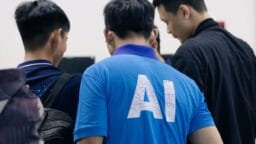Robotic Advancements in Tokyo: A Glimpse into the Future
Tokyo: A duo of agile, anthropomorphic robotic arms, designed specifically for the realm of physical artificial intelligence research, adeptly mimics the fluid motions of an operator donning a VR headset, akin to an illusionist performing captivating tricks.
Enactic, a pioneering company based in Tokyo, asserts that with sufficient training, such robotic appendages may autonomously accomplish daily chores, including dishwashing and laundry, particularly addressing labor shortages in Japan’s care facilities.
Welcome to an age wherein artificial intelligence infiltrates the tangible landscape, manifesting through sophisticated robots, autonomous vehicles, and a plethora of self-sufficient machines.
“The forthcoming evolution of AI is physical AI,” proclaimed Jensen Huang, the CEO of American tech titan Nvidia, last year. He elucidated that this paradigm encompasses “AI that comprehends the laws of physics, AI that can coexist with humans” and possesses an understanding of “how to perceive the world.”
Substantial investments are being funneled into the domain of physical AI, with Morgan Stanley forecasting that the global population of humanoid robots could exceed one billion by 2050.
The excitement is accentuated by viral videos depicting advanced androids, predominantly of Chinese origin, showcasing their abilities by dancing to Taylor Swift or effortlessly hauling heavy objects.
This technological renaissance, while promising a future populated by robotic aides, has ignited anxieties surrounding employment displacement, privacy concerns, and the timeline for these innovations to become genuinely functional.
At the forefront, 24-year-old CEO Hiro Yamamoto of Enactic has equipped esteemed institutions such as Nvidia and Stanford with their OpenArm training devices.
He intends to commence the deployment of new robotic prototypes next summer, catering to environments characterized by chaos and continuous change, such as care homes.
“Safety is paramount,” he emphasized, assuring that these robots will feature a pliable exterior to prevent harm.
Exploring Human Roles
In Guangzhou, China, a humanoid figure adorned with a luminous oval visor for a visage, donned in white synthetic fabric reminiscent of a fencing outfit, gracefully traversed a stage amidst a flurry of applause and murmurs.
This unveiling marked the latest advancement from XPeng, a Chinese electric vehicle manufacturer diversifying into physical AI.
Despite the headlines generated by nimble creations from companies such as Boston Dynamics, domestic rivals in China, including Unitree Robotics and EngineAI, are gaining momentum owing to robust governmental support and thriving supply chains.
“I haven’t quantified how many robots we will sell annually in ten years, yet I foresee the numbers surpassing those of automobiles,” remarked XPeng CEO He Xiaopeng during a press briefing.
XPeng’s robots can walk and dance autonomously, though their proficiency in object manipulation remains largely unverified.
With the exorbitant cost of replacing a single robotic hand, which is imperative for strenuous tasks, it could cover a worker’s salary in China for an extended period.
Nonetheless, given adequate data and training, AI-driven humanoid robots could potentially fulfill “nearly any human role,” ranging from caregivers to culinary experts, as stated by XPeng co-president Brian Gu.
On-the-Job Training Initiatives
While text-based AI tools, such as ChatGPT, rely on vast amounts of text data, physical AI models are tasked with understanding visual stimuli and the spatial relationships among objects.
Currently, the most effective method of training AI robots to perform tasks such as cup retrieval involves teleoperation, according to Yamamoto, who mentioned that merely 30 to 50 demonstrations suffice to optimize “vision-language-action” models.
Enactic has engaged with numerous care facilities in Japan to propose integrating its teleoperated robots into menial tasks, thereby allowing skilled care workers to dedicate more attention to elderly residents.
This experiential training will sharpen physical AI models for future autonomous operation, noted Yamamoto.
Similarly, US-Norwegian startup 1X is adopting this approach with its humanoid home assistant, NEO, scheduled for delivery to American households next year.
Despite its $20,000 price tag, the robot’s performance remains inconsistent, as evidenced by reports of NEO struggling to operatively close a dishwasher door, even under remote control.
The Physical Limitations
In an unfortunate debut, Russia’s purported first humanoid robot stumbled and fell flat on its face during its introduction earlier this week.
A significant disparity persists between the AI capabilities and physical prowess of robots, as emphasized by Sara Adela Abad Guaman, a robotics assistant professor at University College London.

“Nature demonstrates that to adapt successfully to the environment, possessing the appropriate form is essential,” noted Abad, illustrating her point with the analogy of a mountain goat traversing icy terrain.
Regardless, substantial financial agreements are being established as investments in artificial intelligence continue to surge, prompting concerns over a potential stock market bubble.
Japan’s SoftBank recently identified physical AI as its “next frontier,” announcing the acquisition of industrial robot maker ABB Robotics for a staggering $5.4 billion.
Though the issue of automation raises questions regarding the future of human employment, Abad expresses little alarm, reiterating that “our sense of touch is unparalleled.”
Source link: English.mathrubhumi.com.





